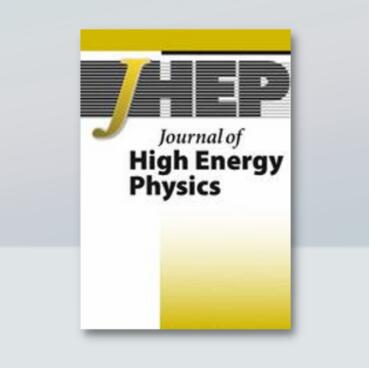alp向暗光子暗物质的绝热转换
IF 5.5
1区 物理与天体物理
Q1 Physics and Astronomy
引用次数: 0
摘要
我们介绍了一种机制,通过该机制,在背景磁场的存在下,失调的ALP可以动态地转化为暗光子。大量的非相对论性ALPs将转化为具有与背景场的非均匀性顺序的动量的暗光子;因此,一个高度均匀的场将产生非相对论性的暗光子,而不依赖于它们的动量的任何红移。利用一阶相变产生的隐藏扇区磁场,该机制可以在低至10−13 eV的大范围暗光子质量范围内再现暗物质的残余丰度。本文章由计算机程序翻译,如有差异,请以英文原文为准。
Adiabatic conversion of ALPs into dark photon dark matter
We introduce a mechanism by which a misaligned ALP can be dynamically converted into a dark photon in the presence of a background magnetic field. An abundance of non-relativistic ALPs will convert to dark photons with momentum of order the inhomogeneities in the background field; therefore a highly homogeneous field will produce non-relativistic dark photons without relying on any redshifting of their momenta. Taking hidden sector magnetic fields produced by a first order phase transition, the mechanism can reproduce the relic abundance of dark matter for a wide range of dark photon masses down to 10−13 eV.
求助全文
通过发布文献求助,成功后即可免费获取论文全文。
去求助
来源期刊

Journal of High Energy Physics
物理-物理:粒子与场物理
CiteScore
10.30
自引率
46.30%
发文量
2107
审稿时长
1.5 months
期刊介绍:
The aim of the Journal of High Energy Physics (JHEP) is to ensure fast and efficient online publication tools to the scientific community, while keeping that community in charge of every aspect of the peer-review and publication process in order to ensure the highest quality standards in the journal.
Consequently, the Advisory and Editorial Boards, composed of distinguished, active scientists in the field, jointly establish with the Scientific Director the journal''s scientific policy and ensure the scientific quality of accepted articles.
JHEP presently encompasses the following areas of theoretical and experimental physics:
Collider Physics
Underground and Large Array Physics
Quantum Field Theory
Gauge Field Theories
Symmetries
String and Brane Theory
General Relativity and Gravitation
Supersymmetry
Mathematical Methods of Physics
Mostly Solvable Models
Astroparticles
Statistical Field Theories
Mostly Weak Interactions
Mostly Strong Interactions
Quantum Field Theory (phenomenology)
Strings and Branes
Phenomenological Aspects of Supersymmetry
Mostly Strong Interactions (phenomenology).
 求助内容:
求助内容: 应助结果提醒方式:
应助结果提醒方式:


